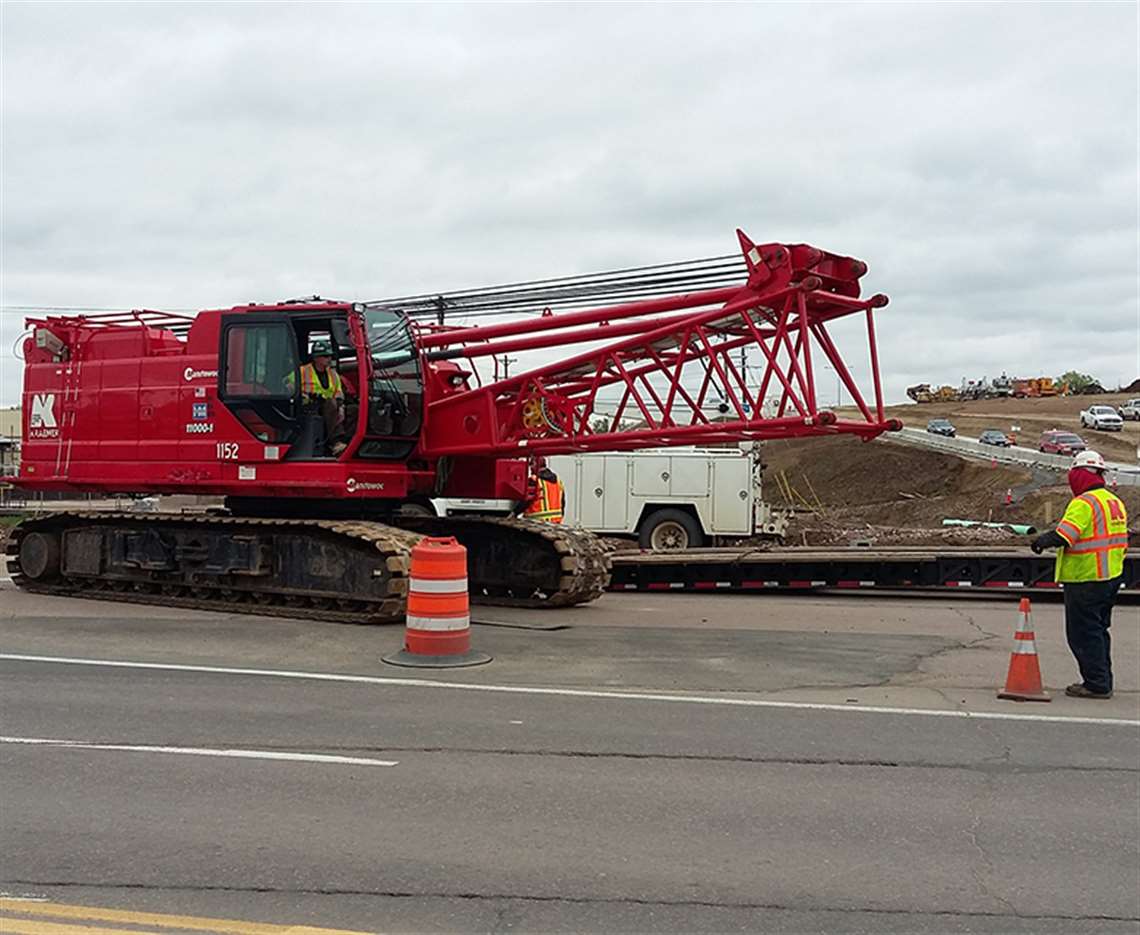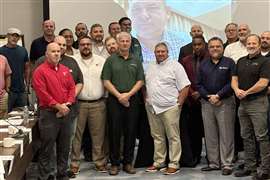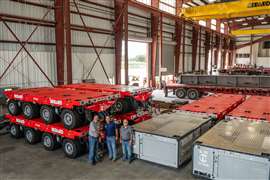OSHA Crane Requirements FAQs- Part Two
07 April 2021
This is part two of a two-part series covering common questions about OSHA crane training requirements. See part one here.

WHAT DO OSHA OPERATOR TESTS COVER?
OSHA is specific about what areas have to be covered and has listed what it regards as essential knowledge and skills listed in paragraphs (j)(1) and (2) of 1926.1427.
WHAT IF THERE IS NO CERTIFICATION AVAILABLE FOR A SPECIFIC TYPE OF CRANE?
If no accredited testing agency offers certification for a particular type of equipment, then an operator will be have to be certified for the type of crane that is “most similar.” From mobile cranes to overhead cranes, Easybook has you covered. Check out our available courses now.
HOW I DETERMINE WHAT TYPE OF CRANE IS “MOST SIMILAR”?
As a service to industry, the NCCCO Foundation has established a group of crane industry experts to address this very issue. The Crane Type Advisory Group (CTAG), referenced by OSHA in the Preamble to the Final Rule, has made several determinations as to what type is “most similar” to cranes for which a certification is program is not available. Requests for determination can be sent to [email protected].
WHAT IF OPERATORS DON’T SPEAK OR READ ENGLISH?
OSHA allows tests to be administered in any language the operator understands. However, it comes with conditions: The operator is only permitted to operate cranes equipped with operations manuals and load charts that are written in the language of the certification (which must be stated on the certification card), and he/she must be able to effectively communicate with the signal person and lift director in the language used. And, of course, the crane operator testing organization has to have exams available in that language [§ 1926.1427(h)(2)].
DO ALL CRANE OPERATORS NEED TO BE CERTIFIED IN THE US?
Operators of most cranes above 2,000-pound capacity when used in construction need to be certified either by a nationally accredited crane operator testing organization or through an audited employer program [§ 1926.1427(a)].
WHAT DOES A CERTIFIED CRANE OPERATOR NEED TO DO?
Nothing. CCO certification provided by the National Commission for the Certification of Crane Operators (NCCCO) fully meets the requirements of the OSHA rule. This applies to certifications of operators of all the crane types NCCCO currently offers (Mobile Cranes, Tower Cranes, Overhead Cranes, Articulating Cranes, Service Truck Cranes) [§ 1926.1427(d)].
WHO IS ACCREDITED?
OSHA now requires all certification organizations providing certification to crane operators to be accredited. There are several certification bodies but only four that are currently accredited.
Accredited by ANSI:
- NCCCO – National Commission for the Certification of Crane Operators
- NCCER – formerly the National Center for Construction Education and Research
- EICA – Electrical Industry Certifications Association
Accredited by NCCA:
- OECP – Operating Engineers Certification Program
Note that not all certification bodies are accredited for all the programs they offer. Employers can verify for themselves which programs are included in the accreditation scope, and which bodies are accredited, by checking directly with the appropriate accrediting agency.
ONCE AN OPERATOR IS CERTIFIED, DOES HE/SHE NEED TO GET CERTIFIED AGAIN?
OSHA states that crane operator testing organizations have to provide a means of recertification at least every five (5) years so as to ensure continued competency in crane operations and knowledge. It is important to maintain certification by recertifying during the five-year certification period. If a certification lapses the certification process has to start all over again. [§ 1926.1427(d)(4)].
IF AN OPERATOR LEAVES TO GO TO ANOTHER EMPLOYER, CAN HE/SHE TAKE THE CERTIFICATION WITH HIM/HER?
If the certification was provided by an accredited crane operator testing organization, it is considered “portable” and an operator can take it with him/her, even though the employer paid for it. If the certification was issued through an audited employer program, that certification is not portable. [§ 1926.1427(d)(3)].
HOW DOES OSHA DEFINE A “CRANE”?
The standard defines a “crane” as “power-operated equipment that, when used in construction, can hoist, lower and horizontally move a suspended load” [§ 1926.1400(a)(1)].
OPERATORS OF WHAT TYPE OF CRANES NEED TO BE CERTIFIED?
Cranes covered by the rule, when used in construction applications, include mobile cranes, crawler cranes, tower cranes, boom trucks, articulating boom (knuckleboom) cranes, floating cranes, cranes on barges and locomotive cranes. Also included are industrial cranes (such as carrydecks), pile drivers, service/mechanic trucks with a hoisting device, monorails, pedestal cranes, portal cranes, overhead and gantry cranes, straddle cranes, and variations of such equipment. It also includes multi-purpose machines when configured to hoist and lower (by means of a winch or hook) and horizontally move a suspended load [§ 1926.1400(a)(1)].
ARE ANY LIFTING DEVICES EXCLUDED?
OSHA has excluded many lifting devices, among them: excavators, backhoes (even when used to lift suspended loads), concrete pumps, aerial lifts, tow trucks, digger derricks, gantry systems, and forklifts. All tree trimming and tree removal work is also excluded [§ 1926.1400(c)]. However, in some circumstances, many of these can be included when used in certain specialized tasks (see OSHA 1926.1400(c) Exclusions.)
ARE ARTICULATING CRANES (KNUCKLEBOOMS) INCLUDED?
When used purely to deliver materials, articulating/knuckleboom truck cranes are excluded. However, when they are used to hold, support or stabilize material to facilitate a construction activity, or they are handling prefabricated components (such as roof trusses or wall panels) or structural steel, they are covered by the new rule [§ 1926.1400(c)(17)]
HOW DOES THE RULE AFFECT ELECTRIC UTILITY PERSONNEL WHO OPERATE DIGGER DERRICKS?
Digger derricks are specifically excluded from the new rule when used for auguring holes for poles carrying electric and telecommunication lines or any other work that falls within the scope of OSHA 1926 Subpart V [§ 1926.1400(c)(4)]. However, when used in other construction lifting duties, digger derricks are not excluded. [Preamble p. 70]
I OPERATE A CRANE WITH A MAXIMUM LIFTING CAPACITY OF 10 TONS, BUT I NEVER PICK UP LOADS LARGER THAN 2,000 POUNDS. DO I NEED TO BE CERTIFIED?
Yes. The exclusion for cranes of 2,000 pounds and below refers to the maximum manufacturer-rated capacity. Even if lighter loads are lifted, it is the crane’s maximum-rated capacity that must be 2,000 pounds or less for the operator to be exempt from the requirements of 1926.1427. Employers are still responsible for training their operators on the safe operation of the type of equipment the operator will be using [§ 1926.1441(e)].
HOW ABOUT CRANES WITH ATTACHMENTS?
The rule applies to cranes when used with attachments such as hooks, magnets, grapples, clamshell buckets, orange peel buckets, concrete buckets, draglines, personnel platforms, augers or drills and pile driving equipment, whether attached to the crane or suspended [§ 1926.1400(b)].
DO OPERATORS NEED TO BE CERTIFIED IF THEY WORK IN GENERAL INDUSTRY RATHER THAN CONSTRUCTION?
OSHA 1926.1400 covers cranes in construction only. For crane work in general industry, refer to the applicable OSHA 1910 sections, such as 1910.179 and 1910.180. There are no federal operator certification requirements at this moment in general industry [§ 1926.1400(a)], however some state and local jurisdictions may require operator certification or licensure while using a crane for general industry activities.
WHAT IS AN EMPLOYER REQUIRED TO DO UNDER OSHA’S NEW EVALUATION REQUIREMENT?
The rule states that, effective February 7, 2019, an employer must conduct an evaluation of each operator to ensure he/she is qualified by a demonstration of (i) the skills and knowledge necessary to operate the equipment safely, and (ii) the ability to recognize and avert risks associated with the operation.
WHAT DOES OSHA MEAN BY “SKILLS AND KNOWLEDGE”?
The skills and knowledge OSHA has identified include those specific to the safety devices, operational aids, and software the crane is equipped with. Most importantly, the evaluation must take into account the size and configuration of the crane he/she plans to operate including (but not limited to) the crane’s lifting capacity, boom length, any attachments (such as a luffing jib), and counterweight set-up.
WHAT ELSE MUST THE EVALUATION CONSIST OF?
The evaluation must also cover the operator’s ability to perform the hoisting activities required for the work he/she is assigned, including, if applicable, blind lifts, personnel hoisting, and multi-crane lifts.
CAN AN EMPLOYER GO BY OSHA’S STANDARD DEFINITION OF A “QUALIFIED PERSON”?
No. The Rule is very clear on this. OSHA states that the definition of ‘‘qualified’’ in §1926.32 does not apply here. In other words, possession of a certificate or degree cannot, by itself, qualify an operator to operate cranes.
WHO CAN CONDUCT THE EVALUATIONS?
They must be conducted by someone who has the “knowledge, training and experience necessary” to assess equipment operators.
CAN AN EMPLOYER DELEGATE THESE EVALUATIONS TO SOMEONE ELSE?
The evaluator must be an employee or be acting as the employer’s agent. If employers delegate the evaluations to an agent, they are still responsible for ensuring they are done correctly.
HOW SPECIFIC DO THE EVALUATIONS HAVE TO BE?
Once an employer has successfully evaluated an operator for the necessary skills and knowledge for the size and configuration of crane he/she plans to operate, the employer may allow that operator to operate other equipment that does not require substantially different skills, knowledge, or ability to recognize and avert risk to operate.
DOES THE EMPLOYER HAVE TO DOCUMENT THE EVALUATION?
Yes. The documentation must be available at the worksite and must include: the name of the operator and the evaluator; the date of the evaluation; and the make, model and configuration of the crane used in the evaluation. The evaluator also has to sign it.
DO THE EVALUATIONS AN EMPLOYER HAS ALREADY DONE COUNT?
Yes, for operators employed prior to December 10, 2018, the previous assessments can be used in lieu of conducting a new evaluation of that operator’s existing knowledge and skills. The documentation must note the date of the assessment and the make, model, and configuration of the crane on which it was done.
HOW OFTEN DO THE EVALUATIONS HAVE TO BE CONDUCTED?
Re-evaluations are required whenever retraining an operator is done and whenever an employer believes it’s necessary based on an operator’s performance or an evaluation of the operator’s knowledge. The re-evaluation need only focus on the area(s) which the retraining covered.
ARE EVALUATIONS DONE BY A PREVIOUS EMPLOYER VALID?
No. Evaluations are not portable. Employers must conduct their own.
WHAT IS THE DIFFERENCE BETWEEN CRANES IN GENERAL INDUSTRY VS. CONSTRUCTION?
If crane work does not fall under one of the special standards, such as Construction or Maritime, then OSHA usually considers it to fall under general industry (29 CFR 1910.180). OSHA generally considers construction to include the building, altering, or repairing of new or existing structures. Construction work also includes demolition and deconstruction of a portion, or all, of a structure. Maintenance may also be considered construction depending on its complexity and scope. Since similar work can fall into either category depending on the exact nature of the job, the general approach often adopted is: Go with the stricter standard.
Now that your questions are answered, head over to Easybook Training to find the right crane training course for your needs.
STAY CONNECTED


Receive the information you need when you need it through our world-leading magazines, newsletters and daily briefings.
CONNECT WITH THE TEAM











